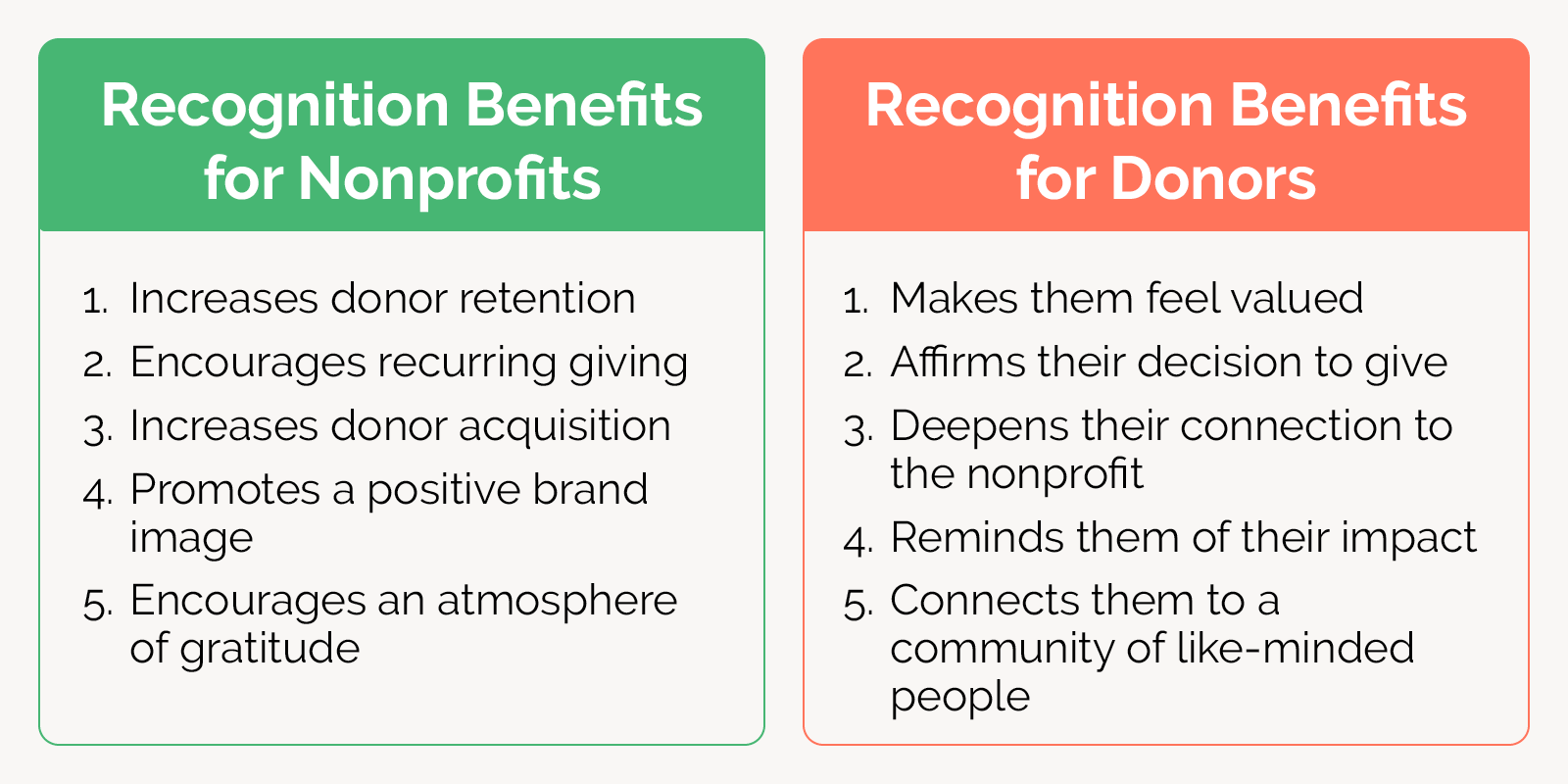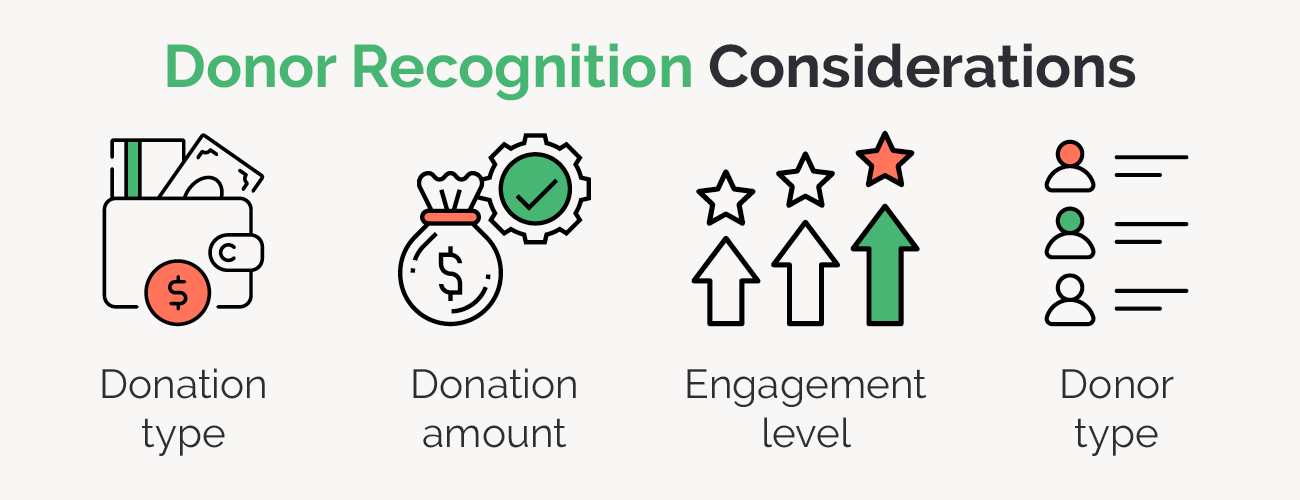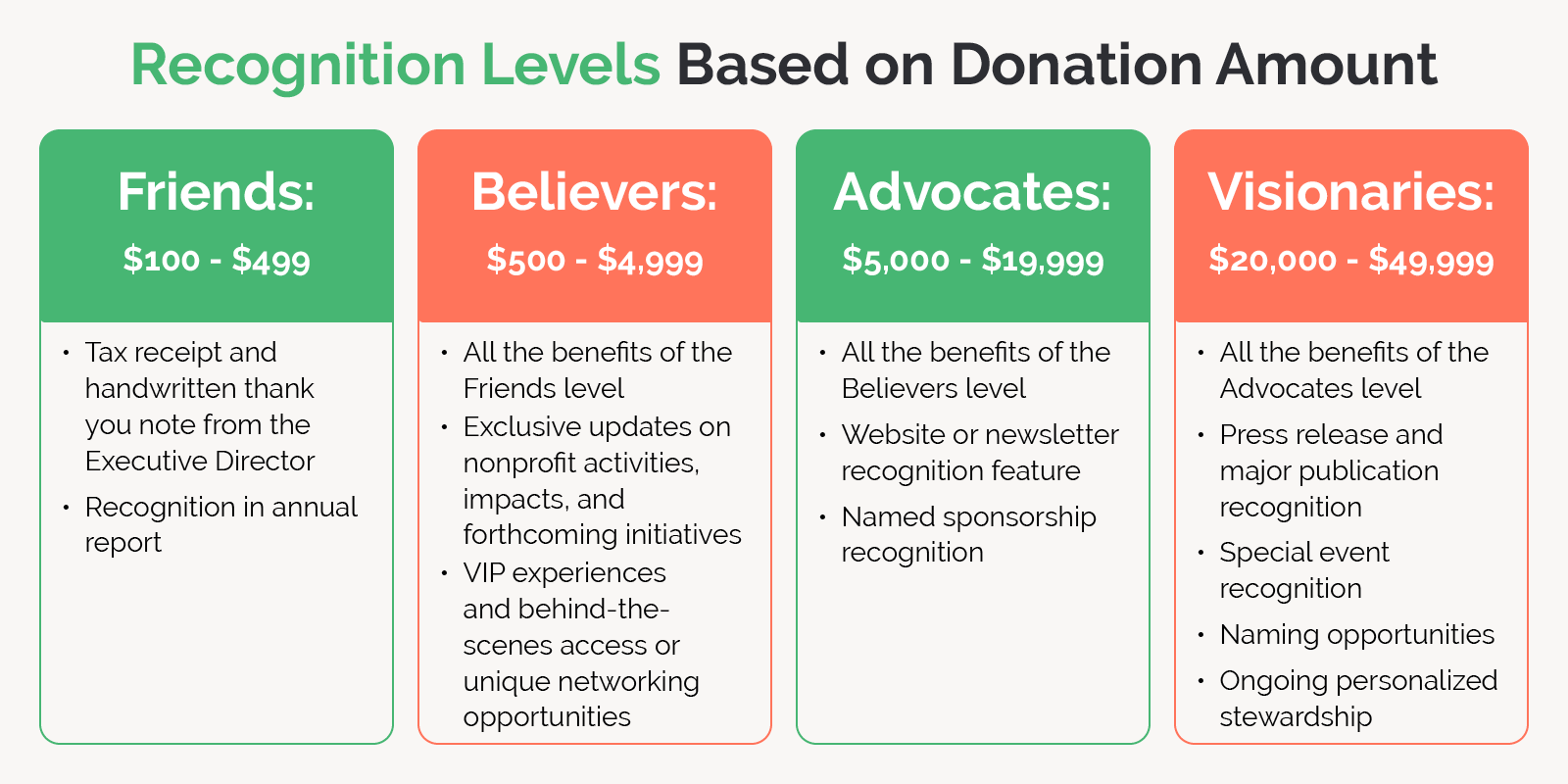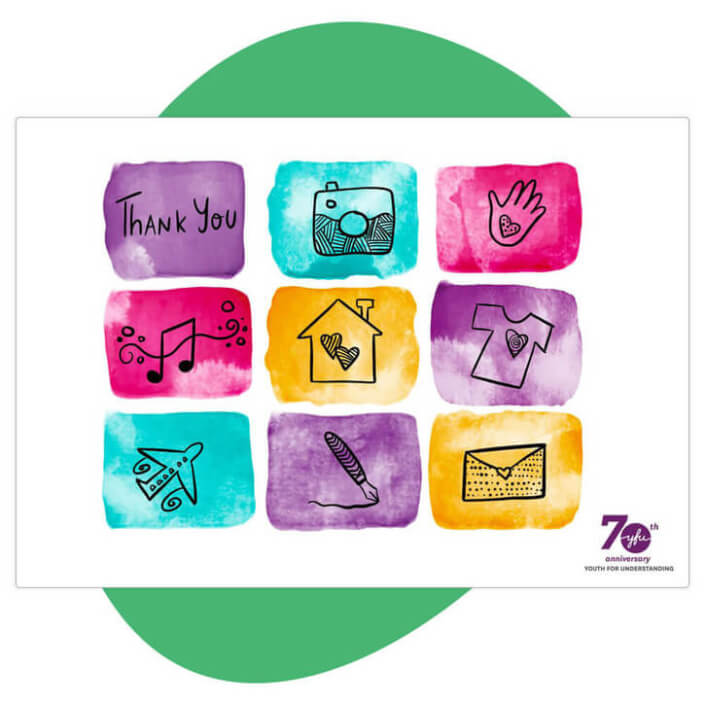Donor Recognition: When & How to Acknowledge Supporters
What would you do if your organization hit a record number of new donors within a year?
Celebrate! But what about after the initial excitement wears off? Discovering that donors share the same passion for your cause is exhilarating. However, many organizations fail to communicate their appreciation adequately, which can have negative retention effects.
In fact, lack of recognition is one of the top five reasons why donors choose to stop giving. That said, donor recognition is a key part of donor stewardship, which can usher first-time donors into long-term supporters.
In this guide, we’ll explore the ins and outs of donor recognition and discover how your organization can create an effective acknowledgment strategy. Let’s dive in!
What is donor recognition?
Donor recognition describes the practice of thanking your organization’s donors for their gifts to your nonprofit. It’s a way for nonprofits to express gratitude and reinforce supporters’ commitment to the cause.
Many nonprofits separate recognition into tiers based on the type of gift and amount given by a donor. We’ll explore this concept more later, but for now, know that nonprofits refer to this tier system to ensure their recognition level matches a donor’s generosity.
There are several methods for recognizing donors. Everything from a simple phone call to a fancy outdoor display falls under this category. At the most basic level, you should send a prompt donor thank-you letter or email acknowledging them for responding to your fundraising appeal and supporting your mission. As with any nonprofit fundraising letter, this thank-you should:
- Be personalized with the donor’s preferred name
- Include relevant, engaging images
- Convey the impact of the donor’s support
Despite the various methods, the purpose of every donor recognition strategy is always the same: to acknowledge a donor’s generosity.
Why does donor recognition matter?
Donor recognition is a vital component of nonprofit fundraising and relationship-building. It’s what inspires donors to stick around and continue supporting your cause, so you can pursue your mission and build a community behind your cause. Let’s explore how meaningful donor recognition impacts both nonprofits and their donors.
Benefits for Nonprofits
Acknowledgment plays a fundamental role in acquiring, retaining, and inspiring greater support. For nonprofits, meaningful donor recognition helps:
- Increase donor retention. Recognizing donors makes them feel like they are making a difference. It also indicates that your organization prioritizes showing appreciation regardless of the gift amount.
- Encourage recurring giving. Donors who feel recognized are more likely to give more and give more often. When you take time to recognize a donor’s gift, you indicate that they’ve made a smart choice to donate to your cause.
- Acquire more donors. Recognizing donors publicly can act as a form of social proof. When people see their friends donate to a cause, it motivates them to explore the organization and maybe get involved themselves.
- Promote a positive brand image. Organizations that prioritize donor recognition further their positive perception in people’s minds. People notice when nonprofits go the extra mile for their supporters.
- Encourage an atmosphere of gratitude. Staff, volunteers, and other supporters want to work for an organization that expresses gratitude regularly. The positive emphasis on appreciation creates a vibrant work culture.
Nonprofits rely on their donors to power their missions, making proactive recognition a vital part of their fundraising efforts. From retaining donors to expanding your community of supporters, showing gratitude goes a long way.
Benefits for Donors
On the other side of things, proper acknowledgment can impact donors in several ways, too. Here’s a quick rundown of how you can influence supporters by recognizing them:
- Make donors feel valued. Donors like knowing that their gift is appreciated. Frequently showing recognition makes them feel valued as important contributors to your organization.
- Affirm their decision to give. Donors could have given to any cause, or not given at all. When you recognize their contributions, you reassure them that they made the right choice.
- Deepen their connection with your organization. When organizations recognize donors individually, it makes them feel like a part of the team. This deepens their connection and can even encourage them to get involved in other ways like volunteering.
- Remind them of their impact. With plenty of distractions, donors can easily forget to support your organization regularly. But, when you recognize them, you remind them of their special part in driving impact. After all, 41% of donors will give again when they receive personalized outreach on the impact of their support.
- Offer community connections to like-minded people. Recognition policies, especially event-oriented ones, allow donors to connect with like-minded individuals and expand their personal and professional networks.
As you can see, consistent donor recognition accomplishes both nonprofit-related and donor-related objectives. That’s why creating a robust recognition program now can cause positive ripple effects for your organization for years to come.
When should you recognize donors?
The short answer: as soon as the gift is received. Expressing acknowledgment and gratitude promptly is what makes donor recognition matter. After all, saying thank you a few weeks or even a few days later does not carry the same meaning. Instead, aim to recognize a donor within 48 hours of receiving their gift.
Of course, more involved recognition strategies like a naming opportunity will take longer to complete. However, all donors should receive a prompt and personalized acknowledgment. More specifically, plan to thank donors at every touch point. For example, capital campaigns should use donor recognition strategies that actively support the larger campaign purpose and complement each stage of the project.
Who should your nonprofit recognize?
Your goal should be to make all supporters feel recognized and valued for their contributions, regardless of the size of their gift.
But, it’s important to choose recognition strategies that adequately address the level of a donor’s generosity. Responding with an unexpected abundance or limited amount of recognition can throw your donor relationships off-kilter, leading to feelings of dissatisfaction.
To avoid this, you’ll need to create donor recognition levels based on donation type, donation amount, engagement level, and donor type. Let’s explore each in more detail below!
Donation Type
There are several different donation types, from matching gifts to in-kind donations. Generally, donors give through one of the following donation methods:
- Cash: Direct monetary deposit to your nonprofit organization.
- In-Kind: Food supplies, medical supplies, or other tangible goods.
- Time: Donors can choose to devote part of their time to volunteering with your organization and may even apply for volunteer grants to help you raise more funds.
- Matching Gifts: Many corporations offer matching gifts as a part of their philanthropic initiatives, meaning they match their employee’s donations at a 1:1 or 2:1 ratio.
Depending on the type of donation, you can organize your recognition program to acknowledge donors’ specific gifts. For instance, if a donor opts to give through a matching gift program, your recognition should acknowledge their thoughtfulness in doubling their donation.
Donation Amount
Many nonprofits segment their donor tiers by donation amount. How you determine the tiers will depend on your organization’s average donation size. A smaller nonprofit’s average donation size might be $200 while a more established nonprofit’s average donation size might be closer to $2,000.
For example, a community-based nonprofit’s donation recognition levels might look something like this:
- Friends: $100 – $499
- Tax receipt and handwritten thank-you note from the Executive Director
- Recognition in annual report
- Believers: $500 – $4,999
- All the benefits of the Friends level
- Exclusive updates on nonprofit activities, impacts, and forthcoming initiatives
- VIP experiences and behind-the-scenes access or unique networking opportunities
- Advocates: $5,000 – $19,999
- All the benefits of the Believers level
- Website or newsletter recognition feature
- Named sponsorship recognition
- Visionaries: $20,000 – $49,999
- All the benefits of the Advocate level
- Press release and major publication recognition
- Special event recognition
- Naming opportunities
- Ongoing personalized stewardship
You can also organize these levels based on impact. For instance, a food pantry might categorize amounts by their ability to feed five families, 50 families, or 250 families. Adjust the amounts and the recognition titles to best suit your organization’s average donation size and mission impact.
Engagement Level
You can also categorize donors by their engagement level with your organization. This identifier will significantly impact how you decide to recognize them. Here are the various engagement levels to consider:
- First-time donors: It’s important to promptly recognize first-time donors to affirm their decision to give to your cause and welcome them to your organization. Welcome packets full of fact sheets about your organization, branded merchandise, a thank-you note, and upcoming volunteer opportunities are a great way to recognize new donors.
- Repeat donors: Currently active donors who know your organization well are also worth recognizing. Show them your appreciation with personalized phone calls, exclusive nonprofit updates, and event invitations tailored to their interests.
- Major donors: Donors who give significant amounts of money to your cause deserve thoughtful recognition. Keep them in the loop with specialized impact reports and dedicated donor thank-you events as a part of your stewardship efforts.
- Legacy donors: People who decide to dedicate their life’s earnings through planned gifts or estate plans qualify as legacy donors. Include these generous individuals in legacy society publications and send them exclusive updates on their future gifts’ impact.
You can categorize this donor data within a dedicated CRM so that your team can reference and update it throughout your relationship. That way, you’ll never miss a beat when recognizing new or long-time donors.
Donor Type
When you think of donor recognition, you might primarily think of individual contributors. However, there are a few different types of donors, and you should adjust your recognition strategies for each type. Donor types differ across three major categories:
- Individual donors are private individuals who contribute their personal funds. They are the most common type of donors and range from small contributors to high-net-worth individuals making major gifts.
- Corporate donors are companies that provide financial support or other resources. Corporate giving takes various forms, such as monetary donations, in-kind contributions, employee volunteer programs, or cause-related marketing partnerships.
- Foundations are organizations formed to provide funding and support to charitable causes. They can be private (i.e., established by individuals or families) or public (i.e., government-funded or endowed by corporations).
As mentioned, you’ll need to adapt your recognition efforts for each donor type. For example, personalized acknowledgments and donor spotlights are suitable for individual donors, while corporations might benefit from specialized CSR employee engagement programs. Foundation recognition, on the other hand, would take the form of grant acknowledgments.
Top Donor Recognition Ideas
Depending on the above considerations for each donor, there are several ways you can recognize them. As always, you’ll need to match the strategy to your relationship with the donor for maximum impact. Here are some top recognition ideas based on engagement levels and donation amounts:
Digital eCards
To make your recognition both prompt and personalized, use digital eCards. This approach allows you to send a branded thank you to donors. These digital tools make it easy to honor donors and spread the word about your cause. It’s as simple as logging in, customizing your design, drafting a thank-you, and sending it to your donor’s social media account or inbox.
Not to mention, eCards are a great source of revenue when you sell them to supporters, too. Check out this video for an in-depth review of how this technology works:
From thanking donors to raising funds, digital greeting cards can add a special touch to your fundraising techniques. Greeting cards are perfect for any occasion, including saying thank you to your valued supporters!
Phone Calls
Simple and straightforward, a phone call from your nonprofit’s Executive Director is a meaningful way to recognize a donor. This strategy will make donors feel seen by your nonprofit’s efforts. Be sure to have the donor’s donation type and amount handy so you can express gratitude for their specific gift.
Branded Gifts
Send your donor nonprofit branded merchandise as a thank-you! Blankets, t-shirts, hats, and hoodies all make for fabulous donor recognition gifts that will make your donor feel welcomed into your organization. If your nonprofit has an online gift shop, consider sending a donor a discount to choose a branded gift that best suits them.
Thank-You Notes from Beneficiaries
Your donors likely expect a thank-you message from your nonprofit’s team, but you can pleasantly surprise them with a handwritten appreciation letter from your beneficiaries. All you need to do is:
- Sign up beneficiaries to write letters. Ensure they know that this is a small time commitment to encourage more people to join.
- Provide writing resources for beneficiaries. Offer items such as a thank-you card template, paper, and pens to make the writing process as easy as possible.
- Coordinate letter drop-off. Instead of sending letters themselves, ask your beneficiaries to drop their thank-you letters off at your office. This way, beneficiaries don’t need to pay for stamps, and your donors’ sensitive information is kept safe.
- Send the thank-you notes to donors. Make sure to send your letters in a timely manner. If you’re worried about stamp prices, look into qualifying for USPS’ nonprofit discount to cut costs.
Take the following example from Youth For Understanding. The nonprofit offers study abroad opportunities, helping young adults learn about the world via semester and year-long exchange programs. They had previous program participants craft thank-you notes to send to their host families or anyone else who made their experience memorable.
This idea is a fun twist on traditional approaches to nonprofit thank-you cards, allowing your beneficiaries to build personal connections with donors and secure their future support.
Social Media Spotlights
Looking for a way to make an individual donor feel special? Social media spotlights are an effective option for highlighting your donor’s generosity. First, make sure your donor follows you online and regularly engages on the platform you choose. Then, with their permission, feature an image of them with a caption describing the impact of their generosity and why your team is grateful for their support. Or, host a livestream during a big campaign to thank donors.
Appreciation Videos
Appreciation videos are great for social media posts and blog posts on your website. These do not need to be long. However, be sure to include your executive staff thanking individuals for their support. You can also include, with their permission, a thank-you from the beneficiaries who your donors have helped. Doing this will help your donors understand the importance of their gifts.
Donor Lunch
Invite your donors to a dedicated lunch to celebrate their generosity. Send an invitation in advance and keep the invite list small to focus on a couple of key individuals. This option is great for donors who would appreciate more than a thank-you note but are uncomfortable attending a large dedicated event.
Donor of the Month Program
While your donors don’t give for the attention, you can still provide public shoutouts to your mid-tier contributors. Unlike social media spotlights, Donor of the Month is a time-bound award that’s given to the donor who’s made a big impact during that calendar month.
For instance, some good candidates for this award include a volunteer who decides to donate for the first time or an existing donor who smashes their peer-to-peer fundraising goal. You can highlight their dedication to your mission by:
- Featuring them in your newsletter
- Allowing them to write a guest post for your blog
- Interviewing them and sharing the video on your website and social media accounts
Ensure your donor consents to being publicly recognized and notify them in advance so you can get your appreciation materials out on time.
Outdoor Displays
Take your recognition outside with a vibrant outdoor display to honor your donors. A nonprofit-specific monument or statue outside your facility can be a valuable addition to your headquarters. Consider partnering with design and construction partners to ensure that your display can withstand weathering and is designed to inspire. Include donor names in a plaque beneath the display.
Donor Plaques or Walls
Probably the most well-known recognition practices, donor plaques and donor walls are popular strategies. Donor plaques honoring the sole donors of a nonprofit project are often posted outside of buildings that the donors funded, for example. Donor walls can display several names and are best unveiled following a capital campaign.
Appreciation Events
Host a virtual happy hour or in-person dinner as a way to say thank you to donors. This can provide a valuable opportunity for donors to network with other supporters and discuss your cause. You could even run an online cooking class or informal craft tutorial. Or, you can make your event larger scale and host a fancy gala; just be sure to keep the focus on donor appreciation.
Donor Hall of Fame
Donor social media shoutouts and Donor of the Month are great ways to publicly appreciate your donors, but you can take this idea to the next level for major donors by starting a Donor Hall of Fame. This honor should be reserved for your most engaged and influential donors and awarded sparingly (e.g. once or twice a year). You can inaugurate donors by:
- Hosting a dinner in their honor
- Adding their picture to a wall in your organization’s office
- Naming events and items after your donors
Unlike Donor of the Month and one-off shoutouts, this idea immortalizes your most impactful contributors. By going the extra mile with this idea, you can demonstrate how donations fuel your mission and that donors forever mark your nonprofit.
Board or Committee Invitations
Invite mid-sized and major donors to serve on advisory boards or committees. This form of recognition engages them more deeply in the organization’s work by showing you value their input and expertise.
Volunteer Opportunities
Volunteering might not seem like an appreciation idea at first glance. However, many donors will appreciate engaging with your cause in new ways. By encouraging donors to volunteer, you’ll deepen their involvement in your mission. This will help them form a more personal connection to the work your organization does and see the impact of donations.
Private Tour
With this donor recognition idea, you’ll show donors where the magic happens! Even though they contribute to your mission substantially, many of your mid-sized and major donors may not have seen your office space and work sites before. Give donors an inside look into your organization by showing them around.
A great chance to use this type of recognition is when someone contributes to fund a specific project or initiative. For example, let’s say a major donor gave to your capital campaign to relocate to a bigger office. You might host an in-person tour or record a virtual one to show them around the new space.
Tips to Level Up Your Donor Recognition
Now that you have some creative donor recognition ideas, it’s time to brainstorm how you’ll cater each one to your unique donor community. Here are some ways to take these donor recognition ideas up a notch:
- Communicate impact. According to Blackbaud, two of the top reasons donors churn are because they never received information on how their gift was used, and they don’t think the organization needs them. Avoid this by tying donations to tangible results. For example, show donors you need their support by telling beneficiaries’ stories and giving them an inside look into their impact.
- Get permission for public recognition. While some donors might love a public shoutout, others might prefer private recognition, like a phone call or letter. Before acknowledging anyone publicly, ask them if it’s okay first!
- Get creative. While a traditional thank-you letter can show appreciation, catch your donors’ attention by testing new recognition techniques. You have tons of powerful technology at your fingertips. Pair that with your team’s creativity, and you’ll come up with out-of-the-box ideas. Even formatting your letters as eCards can make recognition more impactful.
Creating a thoughtful donor recognition strategy can go a long way in showing that you genuinely care about their support. Pay attention to what resonates with donors, and you’ll learn how to show appreciation in more meaningful ways.
Final Thoughts and Additional Resources
Your donors are the reason you can continue pursuing your mission. By properly recognizing them, you’ll increase donor acquisition and retention. Remember, acknowledge your donors often and authentically to convey your nonprofit’s appreciation for them. Be sure to always ask for their permission for public recognition and mention how their specific gift impacted your mission. In turn, thoughtful recognition will pave the way for stronger donor relations.
Did you enjoy this guide to donor recognition? Check out these resources to learn more:
- How to Write The Perfect Donor Thank You Letter – Do you want to make sure you get your thank-you note just right? Follow Kwala’s thank-you note guidelines for tips!
- Donor Data Management: A Quick Guide for Nonprofits – Keep your donor data clean, organized, and accessible with NPOInfo’s guide to donor data management. That way, you can make sure to send the best types of acknowledgment to each donor!
- Get to Know the Basics of Corporate Matching Gift Programs – Did you know that you can double your supporter’s revenue through matching gifts? Learn how in this ultimate guide.










